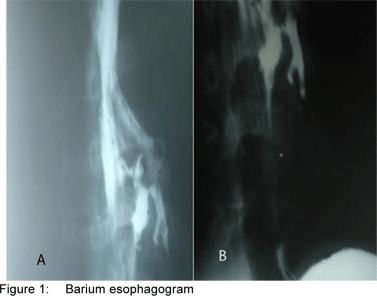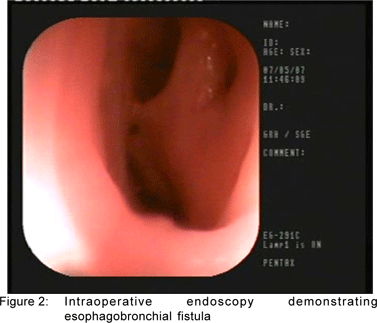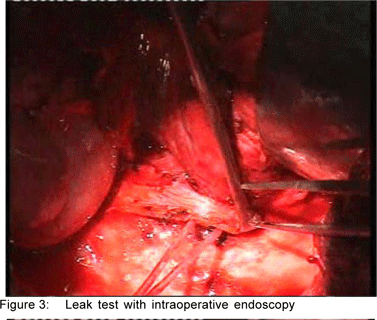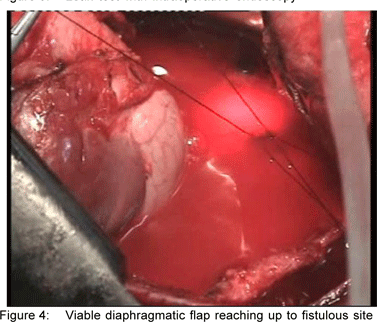48uep6bbphidvals|283
48uep6bbphidcol4|ID
48uep6bbph|2000F98CTab_Articles|Fulltext
Most cases of respiratory esophageal fistulae in adults are acquired.[1,2] Benign causes include prolonged mechanical ventilation, trauma, foreign body ingestion, prior tracheal or esophageal surgery, indwelling stents, granulomatous mediastinal infections, and AIDS.[3] Neoplastic causes could be either primary esophageal or pulmonary carcinomas.[1,2]
When congenital esophagobronchial fistulae (EBF) present in adulthood, a clear distinction between congenital and acquired cases is often difficult.[4]
Adult onset EBFs usually present as one of three clinical pictures: acutely with severe respiratory distress, a chronic picture with repeated aspiration and minimal signs, and sometimes asymptomatic.[5] Less than 200 adult cases have been reported in the literature.[5]Operative repair is associated with a high rate of failure and postoperative complications.[6] Identification of the fistulous tract, surgical division and closure of the fistula may be difficult or unsuccessful because of dense adhesions from recurrent respiratory tract infections or poor blood supply to the ends of the fistulae.
We report a rare case of a congenital Type II esophagobronchial fistula (according to Braimbridge’s classification).[7] The patient underwent successful fistulectomy and repair by the open transthoracic approach. We emphasise the simultaneous use of on-table endoscopy and bronchoscopy.
Case History
A 17-year-old male patient presented with recurrent bronchopulmonary infection, mid-sternal chest pain, recurrent emesis and incidents of choking since childhood. His symptoms were worse with oral feeding. He was referred to our centre with a suspicion of tracheoesophageal fistula. He had undergone surgical correction for cleft palate and misaligned teeth 3 years ago.
His weight and height were at the fiftieth percentile for age. He had a left eye squint and supernumary teeth. He had rhonchi and basilar crepitations, heard with greater frequency on the left side. A barium esophagogram (Figure 1) depicted a patent fistula connecting the esophagus with the left lower bronchial tree well below the level of the carina. An esophagoscopy confirmed the fistula at 28 cm directed towards the left wall below the carinal impression (Figure 2). Fibre-optic bronchoscopy showed a puckering in the left lower bronchus. Computed tomography examination of the chest revealed left lower lobe chronic inflammation with no evidence of pulmonary sequestration.
The history of recurrent pneumonia and reactive airway disease placed him at higher risk for an open procedure. Preoperative evaluation included pulmonary function tests, X-ray chest, ECG and ECHO.
Under general anaesthesia, a flexible fibre-optic bronchoscope was inserted via the ET tube followed by on table esophagoscopy to confirm the level of the fistula. The fistula orifice was confirmed at 28 cm from the central incisors. The esophagocope was left in situ, marking the level of the fistula. With the patient in the right lateral position, an anterolateral thoracotomy was performed through the 5th intercostal space. Pleural adhesions from recurrent pneumonia made it difficult to mobilise the lung.The location of the fistula to the left bronchus was confirmed with the reflection of light from the esophagoscope. The fistula was carefully dissected and umbilical tapes were passed around the exposed fistula and it was transected. The bronchial end was transfixed and sutured with 3-0 vicryl. The esophageal end was closed with interrupted 2 – 0 vicryl in single layer. A nasogastric tube was passed across the repair. An air leak test was conducted using the endoscope’s air insufflators (Figure 3). A diaphragm flap with pedicle (Figure 4) was taken and its length tailored to reach the site of repair. The diaphragm flap was interposed between the repaired ends and anchored. The diaphragm defect was closed with 1 prolene sutures. The wound was closed with a chest tube left in situ.
Postoperatively, nasogastric tube feeding was initiated on postoperative day one. Oral feeding was started on day 7 after a barium esophagogram revealed no leak. The patient was discharged on a normal diet and was free from respiratory symptoms.




Histopathology of the fistulous tract showed normal esophageal mucosa and muscularis mucosa. The patient is symptom-free and has gained 5 kg weight in the postoperative 3 months.
Discussion
The diagnostic standard for congenital EBF in adults, as proposed by Brunner[8] in 1961 is as follows: (1) absence of inflammation around the fistula and esophagus at the time of operation, (2) no adhesion of the lymph nodes to the fistula, and (3) on histology, the fistula has a normal esophageal mucosa and also muscularis mucosa. Braimbridge.[7] classified adult congenital EBF into four types: Type I is a wide-necked diverticulum with an inflammatory fistula at its tip, Type II is a simple fistula, Type III is a fistula with a cyst, and Type IV is a fistula with a sequestrated segment.
The goals of surgical treatment for EBF include division of the fistulous tract, suture closure of the defects of the bronchial tree and the esophagus and interposition of viable tissue to prevent recurrence. Thoracotomy provides a safe approach in view of dense pleural adhesions as a sequel of recurrent pneumonia. Surgical treatment for EBF has 2 problems: (a) esophageal stenosis at the repaired end and (b) recurrence of the fistula. To avoid technical difficulties during the procedure we used an intraoperative esophagoscopy. Esophagoscopy was helpful not only for localisation but also to check the integrity of repair. Moreover esophagoscopic monitoring was necessary to identify leaks and stenoses in the postoperative period. To avoid recurrence, vascularised muscle or pleura can be interposed between the esophageal and bronchial ends. Recently thoracoscopic techniques have been demonstrated as safe and effective.[9]
The first successful bronchoscopic fistula closure using a tissue adhesive was reported in 1975. Subsequently, histoacryl cement, aethoxysclerol, and 30% NaCl have been used in addition to fibrin glue alone or in combination, with mixed results.[6]
In summary, it is recommended that the surgical treatment of congenital EBF should be promptly performed after making a definitive diagnosis to avoid any aggravation of pulmonary complications and a possibly fatal outcome. Transthoracic repair has been practiced now for many years, surgery using a thoracoscope seems the most suitable method, since it reduces the degree of operative invasiveness.
References
1. Coleman FP. Acquired non-malignant esophago-respiratory fistula. Am J Surg. 1957;93:321–8.
2. Helmsworth JA, Pryles CV. Congenital trachoesophageal fistula without esophageal atresia. J Pediatr. 1951;38:610–7.
3. Goussard P, Sidler D, Kling S, Andronikou S, Rossouw GF and Gie RP. Esophageal stent improves ventilation in a child with a broncho-esophageal fistula caused by Mycobacterium tuberculosis. Pediatr Pulmonol. 2007;42:93–7.
4. Blackburn WR, Amoury RA. Congenital esophagopulmonaryfistulas without esophageal atresia: an analysis of 260 fistulas in children and adults. Rev Surg. 1966;23:153–75.
5. Soualhi M, Zahraoui R, Khallafi S, Chaibainou A, Benamor J, Bourkadi JE et al. Congenital esophagobronchial fistula in an adult. Rev Pneumol Clin. 2006;62:399–402.
6. Ogunmola N, Wyllie R, McDowell K, Kay M, Mahajan L.Endoscopic closure of esophagobronchial fistula with fibrin glue. J Pediatr Gastroenterol Nutr. 2004;38:539–41.
7. Braimbridge MV, Keith HI. Oesophagobronchial fistula in the adult. Thorax. 1965;20:226–33.
8. Brunner A. Oesophago-bronchiale fistula. München Med Wochenschr. 1961;103:2181–4. German.
9. Akino Akashi, Shuichi Ohashi ,Takeshi Oriyama, Hiroki Kannu, Hideaki Sasaoka, Yasushi Sakamaki et al. Thoracoscopic treatment of bronchoesophageal fistula with esophageal diverticulum. Surgery laparoscopy and endoscopy 1997;7:491–494